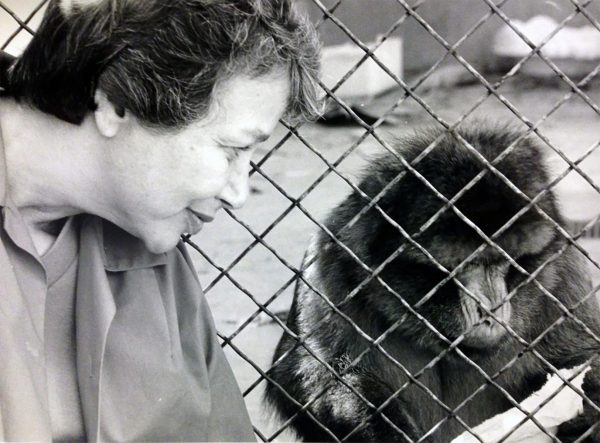EVALYN FINN SEGAL
Richard Gilbert


Eve Segal, an early voice in behavior analysis, died after a fall in Berkeley, California, on January 11, 2017. She had been unwell for some time and had entered an assisted living facility in November 2015.
Eve was born in Pittsburgh, Pennsylvania, on August 16, 1932. Her parents were Rachel Finn and Charles Segal. Her brother, Harold Lewis Segal, 1924-1992, was a long-time professor of biochemistry at the State University of New York, Buffalo. She is survived by her nieces, Robin Lent and Deborah Tudhope, and her sister-in-law, Norma Segal.
Eve’s first undergraduate degree was from the University of Chicago, conferred when she was 17 years old. She gained another undergraduate degree in 1953 – at the University of Minnesota (UM), where her brother was completing his PhD. After a short time at Harvard (Radcliffe College), studying with B.F. Skinner, she returned to UM to earn her PhD (Segal, 1958). Eve’s work was supervised by Kenneth MacCorquodale, who had been Skinner’s student at UM and was on the faculty there. Much of her dissertation research was done at the Institute of Neurological Sciences at the University of Pennsylvania, where Eve spent 1955-56 studying with Eliot Stellar.
MacCorquodale’s strongest impact on Eve was to stimulate a lasting preoccupation with language. In 1953 she had taken his course taught using a mimeographed draft of what later became Skinner’s 1957 book Verbal Behavior.
It was hard for women to secure academic positions in the late 1950s, even though their PhDs were often better regarded than those of their male counterparts. Eve discussed this in an invited address at the annual meeting of the American Psychological Association in 1982, a talk she positioned as celebrating of her fiftieth year on Earth and her thirtieth year as a behaviorist (Segal, 1982).
In her address, Eve said men told her she had no place in the man’s world of science, adding that B.F. Skinner was an exception. She drew attention to his “eloquent statement of feminism in Walden Two.” The character Frazier referred to the predicament of women as a “tradition of slavery.” He added, “The world has made some progress in the emancipation of women, but equality it still a long way off. … To make matters worse, we educate our women as if they were equal, and promise them equality. Is it any wonder they are soon disillusioned?” (Skinner, 1948/1962, p. 146).
Another exception was Merle Turner, a psychology department chair who hired women in tenure-track positions. He invited Eve to join San Diego State College as an assistant professor in 1960 (Figure 1). She remained on and off at what became San Diego State University (SDSU) in 1974 until she retired in 1992. (Merle’s widow, the distinguished economist Marjorie Shepherd Turner, now in her mid-90s, helped with the preparation of this obituary.)
One of Eve’s absences from SDSU involved a year doing research at the Royal College of Surgeons in London, England, in 1965 and 1966. She spent much of the year undergoing psychoanalysis – as many as six sessions a week – while living near the Maresfield Gardens house where Sigmund Freud had died in 1939.
She returned to SDSU but resigned in 1967 to take an appointment at the University of North Carolina (UNC) at Greensboro as director of the Institute of Child and Family Development. At UNC she wrote her most-cited paper for delivery at a conference in Toronto in 1970 (Segal, 1972). It tackled the essential question of what operants are formed from. Put another way, it focused on what in behavior corresponds to variation in evolution, where reinforcement corresponds to selection. This seminal paper is still cited frequently. For example, it is a basis of William Baum’s recasting of reinforcement as induction (e.g., Baum, 2015).
Eve’s work with children at UNC strengthened her interest in verbal behavior. This led to another seminal although less often cited paper (Segal, 1977). In it she sought to demonstrate how Chomsky’s (1965) and Skinner’s (1957) theories complement one another. She concluded, “If this chapter persuades a few cognitive theorists and behaviorists to venture out from their partisan positions and join forces in grappling with the difficult problems of language, it will have succeeded in its aim. (p. 652).” In 2015 she wrote to me, “It’s a pity Skinner and Chomsky were enemies (both at fault, both arrogant). … Chomsky’s books have fascinating analyses of the conditions, verbal and nonverbal, that give rise to specific tacts. … But neither side will read the other side.”
Eve returned to SDSU in 1973 as a full professor and established a primate laboratory. She became an expert in humane animal care and edited a standard tome on the topic (Segal, 1989; and see Figure 2). In her APA address, she characterized herself as a “gay woman behaviorist who loves her laboratory animals” (Segal, 1982). During the 1970s, she served for two three-year terms on the editorial board of the Journal of the Experimental Analysis of Behavior, and again in the mid-1980s.
She took partial retirement in 1983 with the title of emeritus professor, and full retirement in 1992. An SDSU employee who knew her well during this period wrote, “Eve was a brilliant force of nature! She was a bit scary. … I have never in my life known anyone like Eve Segal—gay feminist, proud Jew, outspoken academic and revered by her students.”
In retirement, when her slowly failing health permitted, she indulged her many interests, including photography (for which she won awards), oil painting, and a preoccupation with politics of all kinds, particularly those of the Middle East. She was an agnostic Jew who had strong feelings about the Israeli government’s treatment of Palestinians. She militated for gay rights, assisted suicide, disarmament, and the unionization of college professors.
What may have been her final project was helping me with a novel that features B.F. Skinner as the main character (Gilbert, 2016). For most of 2015 she was my principal reader, receiving the first drafts of chapters as they were completed and much improving them. She knew Skinner and his issues well. She had wise things to say about all the topics of the novel, which include verbal behavior, child development, the politics of 1939, and the biological and philosophical issues of the period.
We continued to exchange emails until mid 2016, when she stopped using her computer. Eve didn’t like using a phone so we stayed in touch through a friend. She was not expected to survive into 2017; but she did, just, and may have lived longer if it were not for the bad fall. I and many others will miss this “force of nature.”

